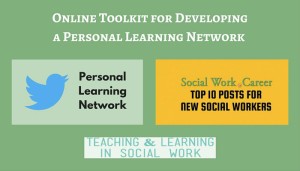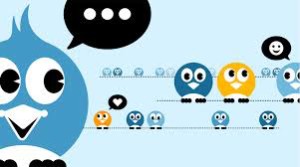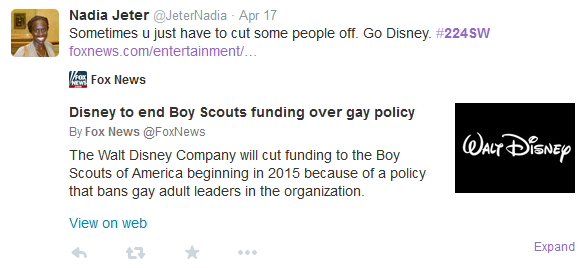Fall 2015 Live Twitter Chat Assignment for Social Work Students
 To help social work students and educators learn about Twitter and develop the skills to participate in a live chat, Jimmy Young of the California State University San Marcos and I (Laurel Hitchcock of University of Alabama at Birmingham) have designed an assignment for social work students that involves joining a live Twitter chat with other social work students, educators and practitioners from around the country to talk about important social and economic justice issues. The assignment is designed for a policy or macro-practice course, but it can be incorporated into almost any social work course. Here are the some of the details of the assignment:
To help social work students and educators learn about Twitter and develop the skills to participate in a live chat, Jimmy Young of the California State University San Marcos and I (Laurel Hitchcock of University of Alabama at Birmingham) have designed an assignment for social work students that involves joining a live Twitter chat with other social work students, educators and practitioners from around the country to talk about important social and economic justice issues. The assignment is designed for a policy or macro-practice course, but it can be incorporated into almost any social work course. Here are the some of the details of the assignment:
1. Students watch the documentary Inequality for All, and then write a brief reaction paper to movie.
2. Then, students participate in the live Twitter chat scheduled for October 8, 2015 at 8:00 PM CST/6:00 PM PST. This chat will be sponsored by #MacroSW, a bi-weekly Twitter chat focusing on macro social work practice issues, and hosted by myself & Jimmy. During the chat, we will ask questions about the film and income inequality that will guide the flow of the conversation.
3. After the live chat, students write a brief self-reflection essay about the experience of participating in the chat.
While the written parts of the assignment are optional to participate in the chat, we highly recommend some type of reflection so students are engaged with the content from the documentary prior to the chat, and have an opportunity to critically assess how the experience can inform their future social work practice. We have written in more detail about the assignment in previous blog posts which include detailed instructions for the assignment, grading rubrics and tips on how to introduce your students to Twitter. Our first chat was held on October 28, 2014, and you can read details about it here, including a transcript of tweets from the conversation. There is no cost to educators or students to participate in the chat, and we welcome anyone, especially social work practitioners, to join the chat.
Because we are working to improve the chat and the assignment as an educational experience for social work students, we are very interested in any feedback from social work educators. Please contact us (by clicking on our names below) if you plan to have your class or maybe a student group participate in the chat. We also welcome questions.
How to cite this post:
Hitchcock, L. I. (2015, October 2).Fall 2015 Live Twitter Chat Assignment for Social Work Students[Blog Post]. Retrieved from https://laureliversonhitchcock.org/2015/10/02/fall-2015-live-twitter-chat-assignment-for-social-work-students/.
Online Toolkit for developing a Personal Learning Network with Twitter
 One of the benefits of having an online presence is making connections with professionals from all over the world. I met Dorlee Michaeli, MBA, LMSW over Twitter a year or so ago. She created and manages Social Work.Career, a blog that provides a variety of resources to help advance an individual’s social work career for current students or experienced mental health professionals. In addition to career-related resources, there are interviews, key learnings from conferences/workshops, licensure exam tips, self-care guidance and more for life-long learning as a social work professional.
One of the benefits of having an online presence is making connections with professionals from all over the world. I met Dorlee Michaeli, MBA, LMSW over Twitter a year or so ago. She created and manages Social Work.Career, a blog that provides a variety of resources to help advance an individual’s social work career for current students or experienced mental health professionals. In addition to career-related resources, there are interviews, key learnings from conferences/workshops, licensure exam tips, self-care guidance and more for life-long learning as a social work professional.
This summer, we created online toolkits for social work educators based on our blogs. Dorlee’s toolkit, Social Work Career’s Online Toolkit for the Social Work Educator, showcases several blog posts from Social Work.Career that will help prepare undergraduate or graduate social work students become more prepared for a career in social work. Also included with the toolkit are some possible classroom assignments/tasks. We tip our hat to Ellen Belluomini who wrote this blog post; she was our inspiration for creating the exercises to meet the 2015 CSWE Social Work Competencies.
Here is my toolkit about developing a personal learning network (PLN) with Twitter:
A personal learning network (PLN) offers social workers and students a practical tool to stay current and share information about latest professional news, practice knowledge, and cutting-edge research findings. I recently wrote about how a social worker can set-up a PLN using professional accounts on different social media platforms.
My favorite social media platform for my own PLN is Twitter, and this post offers tips for using Twitter effectively to maintain and engage with your PLN. All of these tips come from my blog, Teaching & Learning in Social Work, which focuses on teaching and learning in social work. While some of the original posts focus on the social work classroom, the practices and content can be easily adapted by any social work practitioner for their own use with a PLN. Here are eight great ideas for using Twitter with your PLN:
Making Social Policy Relevant Through Social Media
 Dr. Casey Bohrman (@CaseyBohrman) is an assistant professor in the Department of Undergraduate Social Work at West Chester University. In this blog post, she writes about how she uses blogging tools such as Twitter and Tumblr in her social welfare policy courses to engage student in current events and practice advocacy skills.
Dr. Casey Bohrman (@CaseyBohrman) is an assistant professor in the Department of Undergraduate Social Work at West Chester University. In this blog post, she writes about how she uses blogging tools such as Twitter and Tumblr in her social welfare policy courses to engage student in current events and practice advocacy skills.
During the winter of 2013, I frequently listened to Tell Me More, an NPR radio program focused on issues impacting people of color. I noticed that many of the experts on the show came from the “blogosphere” or gained their standing through prolific tweeting. Wanting my social policy class to be relevant to modern policy discussions, I decided to have students join Twitter as part of a class assignment in Spring 2014.
Because Twitter is limited to 140 characters, I also wanted students to have the opportunity to comment on social issues in a more comprehensive fashion. Inspired by David Jaffee, a sociologist from the University of North Florida who blogs about his perspective on current socio-economic issues, I decided to have my students also create blogs. The first time I taught the class we used WordPress, as it was the site recommended to me by our librarian. In future classes, I used Tumblr as it was more user-friendly and allowed for easier incorporation of audio-visual material.
I asked students create a Twitter account and a blog about a particular area of interest, such as mental health policy or how social policy might directly impact women. I asked students to tweet several times per week and post a blog entry once a month about current issues in their policy area. I also asked them to follow a range of accounts from traditional news outlets, advocacy organization, and people directly experiencing an issue. One of the strengths of using Twitter to learn about policy is that it gives students a broader and more current perspective on an issue than they can get from a textbook. It is particularly important for social workers to hear and learn from the perspectives of people who directly impacted by a social issue. For example, there are a number of users who identify with Black Twitter (such as @Feministajones, @Karnythia, and @TheBlackVoice) who provide important perspectives on racial issues.
Follow-up to Live Twitter Chat on March 12, 2015
This is a short post to follow-up on the second live #MacroSW chat that Jimmy Young and I hosted on March 12, 2015 about the documentary Inequality for All. Once again, we had a great turnout and an inspired conversation. Others have written more about this chat, so I am going to direct you to their posts:
1. Chat Statistics: The #MacroSW Chat folks reported that there were almost 100 people on the chat who shared 640 posts in one hour. Here is a link to more analytics about the chat.
2. Chat Transcript: Here is a link to the chat transcript in Storify, a web-based program marketed as a story-telling software. It also is a great tool for summarizing tweets from live chats and other types of conversations on Twitter.
3. Chat Summary: Jimmy Young wrote a solid summary of the chat from the perspective of a social work educator. Like Jimmy, I find live Twitter chats a compelling learning tool for bachelor-level social work students. During the chats, I see students engaging in public discourse on vital policy issues with their peers and other professionals, not just in the classroom. They are actively connecting with others, sharing and thinking critically about poverty issues when participating in a live chat. Look for more information near future from Jimmy and I about using live Twitter chats in the social work classroom.
Again, many thanks to #MacroSW chat and our host from @MSWatUSC, Kristin Battista-Frazee (@porndaughter). They sponsored, promoted and summarized the chat, and are all around great people! Also, a big thanks to all the students, educators and practitioners who showed up and participated in our national conversation – including social work students and educators from University of Buffalo, University of Tennessee, University of Nebraska at Kearney University of Alabama at Birmingham, and Jacksonville State University to name a few.
How to cite this post:
Hitchcock, L. I. (2015, March 16). Follow-up to Live Twitter Chat on March 12, 2015[Blog Post]. Retrieved from https://laureliversonhitchcock.org/2015/03/16/follow-up-to-live-twitter-chat-on-march-12-2015/.
How to participate in a Live Twitter Chat – Tips for Social Workers
 Live Twitter chats (a scheduled event when Twitter users communicate via tweets in real time) can be a great way for social workers and students to stay informed about all types of issues and interests relevant to the profession. For example, medical experts from the Mayo Clinic frequently host chats to share and discuss new treatment options in healthcare. Professionals can also use this tool to meet and talk (for free) with new colleagues from just around the corner to the other side the world. A good example is the #SPSM chat which hosts a weekly forum for mental health professionals interested in using social media to prevent suicide. During a chat like this one, a social worker might engage with influential thought leaders in their field and make their own contributions to the professional conversations that influence and shape social work practice. The Political Social Worker suggests that Twitter can be a powerful networking tool for social workers in her blog post The Benefits of Live Twitter Chats.
Live Twitter chats (a scheduled event when Twitter users communicate via tweets in real time) can be a great way for social workers and students to stay informed about all types of issues and interests relevant to the profession. For example, medical experts from the Mayo Clinic frequently host chats to share and discuss new treatment options in healthcare. Professionals can also use this tool to meet and talk (for free) with new colleagues from just around the corner to the other side the world. A good example is the #SPSM chat which hosts a weekly forum for mental health professionals interested in using social media to prevent suicide. During a chat like this one, a social worker might engage with influential thought leaders in their field and make their own contributions to the professional conversations that influence and shape social work practice. The Political Social Worker suggests that Twitter can be a powerful networking tool for social workers in her blog post The Benefits of Live Twitter Chats.
But participating in a live Twitter chat requires preparation. Live chats move fast and have guidelines to set the parameters of the conversation. More obvious is the need to be familiar with Twitter (a microblogging platform) before participating in a chat. Understanding what a tweet is and how to write one is a must to chat on Twitter. Being able to communicate and network with professionals in online environments is considered an important digital media skill for any 21st century professional including social workers (Rheingold, 2012).
Here are some practical tips for social work students, educators and practitioners interested in being part of a live Twitter chat:
Q & A: Student Perspective on Twitter Assignment
Ms. Bobbi Arrington (@bobbielle) is an instructor at School of Social Work at Monmouth University. In this blog post Ms. Arrington interviews Ms. Nadia Jeter, a BSW student at Monmouth University, who participated in Twitter assignment during an Human Behavior and the Social Environment course. In another post, Ms. Arrington and Dr. Becky Anthony (@becky_anthony ), an assistant professor of social work at Salisbury University, write about how they developed and managed an assignment using Twitter in their Human Behavior and the Social Environment Courses.
Recently, I sat down with Nadia Jeter, a BSW social work student at Monmouth University. Nadia was in Professor Becky Anthony’s class when the Twitter project was started. Nadia and I sat down in the back of a brightly lit classroom, papers and books cluttered the desk as her last class had just finished. She has a bright infectious smile and a large personality that is charismatic. It’s not surprising that she has become a major advocate for vulnerable and marginalized populations using Twitter. It took just a few seconds for her to recall back to the spring of 2013 and the assignment.
BA: What did you initially think of the assignment?
NJ: I hated it! I asked was it mandatory and Professor Anthony, with her nice smile and her hands folded (she imitates Professor Anthony’s hand expression) she said, “Yes – but don’t worry. We’ll show you how to do it!” I had just got on facebook and I hated it! It wasn’t user friendly.
BA: How was it learning to use Twitter?
NJ: It’s actually very user friendly. I took me all of two minutes to set up. It’s really easy, accept for the fact that you have only one hundred forty characters to express yourself! This was a very good tool for me because it was so simple and I really value simplicity.
BA: How did you develop your tweets and how you responded to replies?
NJ: (she laughs) In the end I was actually very thankful that you only have one hundred forty characters! Having only a few words made you choose what was important. You had to take out the bread and just give the meat. Because…yeah…you have to just give them a fact. No explanation. So if you retweet an article you just give them a brief statement. Say you’re reading something and you say to yourself…this is so corrupt. You can retweet and just say “corruption in the judicial system.” The person has to look to see what you are talking about.




